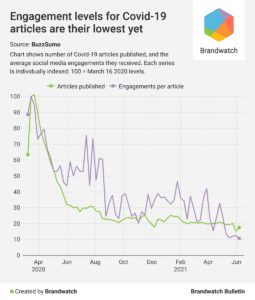This week’s blog comes thanks to Brandwatch. Last year, we looked at the size of the online Covid conversation, along with articles covering the virus. It’s been a long time since we last looked, so we decided it was time to revisit. When we’re talking about Covid-19 articles, these are any online articles that mention that virus that BuzzSumo picks up for us. For article engagements, this refers to actions like Twitter shares and Facebook likes.
And when we refer to the Covid-19 conversation in this instance, we’re talking about the number of unique authors mentioning the virus on Twitter, forums, and blogs. This includes authors writing in Arabic, Chinese, English, French, German, Hindi, Italian, Korean, Persian, Portuguese, Russian, Spanish, and Thai.
Let’s look at Covid-19 articles first.
We can see from the chart on the left that the number of articles about Covid (green line)peaked in March 2020, with 1.8m articles published in the week of March 23. Numbers dropped sharply from April into June, and stayed relatively stable from September onwards.
That remained the case all the way into this year, until we saw a sharp drop at the end of May. By the second week of June, just 307k Covid articles were published, a fall of 83% from the peak. We’re not sure what caused this, so it’ll be interesting to see how things develop and if the change is only short-lived.
Average engagements (purple line) follow nearly the same pattern (aside from a resurgence in the summer of 2020), and are now at their lowest point since the pandemic began. A Covid article is now getting 96 engagements on average, compared to the 892 they got in mid-March 2020.
This could be caused by a number of factors. For example, maybe the content has just got worse as higher quality publishers have shifted their focus to other subjects, or it could be that people have just lost interest in engaging with Covid content in general. This kind of fatigue around Covid news is understandable. But it could also be viewed as dangerous, especially if people are missing out on important updates or safety announcements.
Can we talk about something else?
Looking at the change in the Covid-19 conversation since March 2020, a lack of interest may well be the cause in falling engagements.

This suggests that people are increasingly less interested in discussing the virus after so long (and we don’t blame them). It may even be that people are less likely to refer to Covid specifically, instead using more generic phrasing (like we have by using the word “virus”) now it’s obvious what they would be referring to.
We should note that the chart on the left is more of a global picture. Things look very different in different places. For example, in India, the Covid-19 conversation more than tripled in April 2021 as the country faced a horrific surge in cases. Thankfully cases are on their way down, and the conversation is decreasing with them.


